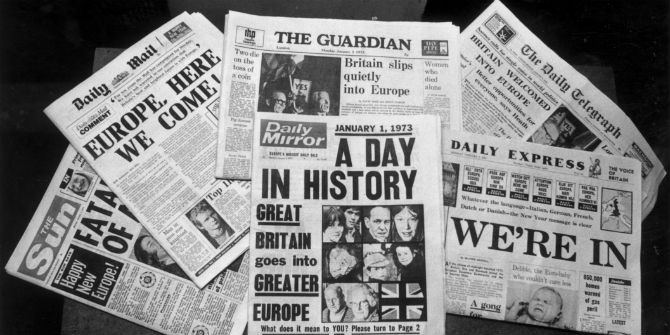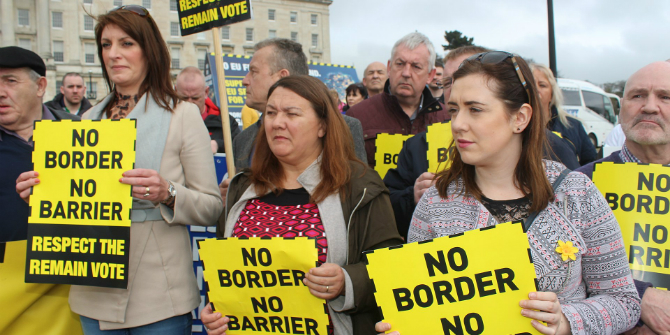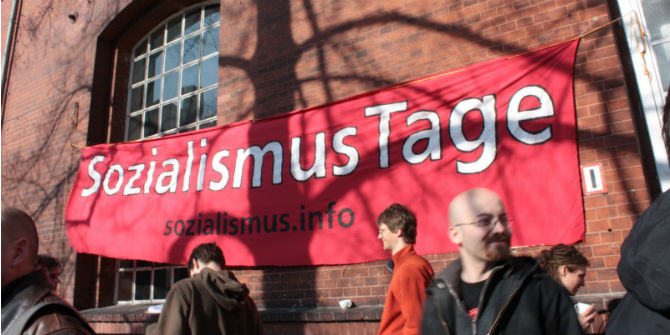 Polling before the 1975 referendum found that women were more sceptical than men about membership of the European Community. In his book Yes to Europe! The 1975 Referendum and Seventies Britain, Robert Saunders (Queen Mary University of London) explains how Britain in Europe’s campaign went about targeting women.
Polling before the 1975 referendum found that women were more sceptical than men about membership of the European Community. In his book Yes to Europe! The 1975 Referendum and Seventies Britain, Robert Saunders (Queen Mary University of London) explains how Britain in Europe’s campaign went about targeting women.
A referendum on the Common Market might seem an unlikely arena in which to debate the roles and responsibilities of men and women. Yet both side paid close attention to women’s votes and crafted material specifically with women in mind. Britain in Europe employed two full-time women’s officers, who were among the highest paid officials in the organisation, while women like Barbara Castle, Judith Hart, Margaret Thatcher and Shirley Williams all took prominent roles in the campaign. On one level, this marked a recognition of women’s electoral power and of the need to craft appropriate campaign messages; yet the assumption that women formed a distinct electoral cohort also marked the continuing resonance of older ideas about ‘the women’s vote’ and the issues that were thought to define it. While men were assumed to have multiple and sophisticated political identities, determined not by their sex but by occupation, political allegiance, religious belief and religious identity, appeals to women still leaned heavily on a set of well-worn feminine tropes: the housewife, the mother and the keeper of the household budget. At a time when feminists were struggling to recast political language, women who campaigned in the referendum found that their voices were most likely to be heard when they spoke in the tones of the wife and mother. Like the traditional cry of the shipwrecked sailor – ‘women and children first’ – the attention paid to women voters was indicative less of their political equality than of their continuing status as a ‘special category’, outside the perceived mainstream of electoral politics.

Britain in Europe (BIE) began by establishing a dedicated Women’s Section. The first task for the new organisation was simply to ensure a proper representation of women’s votes, in what threatened to be a very male-dominated operation. The National Liberal Club, which served as headquarters for the European Movement, did not even admit women to full membership at this time, and it voted to uphold the ban just a month before the referendum. At first, as Women’s Section leaders Kina Avebury and Ann Money-Coutts later recalled, ‘the whole tenor of advertising and publicity… was consistently male-oriented.’ Indeed, the first batch of posters ‘had no women in them at all’. Such material as was designed for women was either crassly chauvinistic – women’s T-shirts, for example, with the words ‘Europe or Bust’ blazoned across the bosom – or thoughtlessly so, like the posters of smiling children labelled ‘Jobs for the Boys’.
If the campaign’s own material was problematic, press coverage was even worse. Slogans like ‘Europe or Bust’ lent themselves readily to the increasingly pornographic culture of tabloid journalism in the seventies. The Mirror had featured a series of ‘Euro-dollies’ during the accession negotiations in 1971, and in 1975 it hired a 22-year-old model called Beverley Pilkington, who posed for the paper in her underwear and a ‘Europe or Bust!’ T-shirt that left little to the imagination.
One solution was for the Women’s Section to produce its own campaign materials, bypassing the largely male publicity office. Avebury and Money-Coutts duly produced a stream of literature, including 1.25m copies of a leaflet covering such issues as jobs, benefits, pensions, the cost of living, peace and security.
The Women’s Section also undertook three more specific tasks. The first was to act as apoint of contact for women’s media outlets, ranging from the ‘women’s pages’ in the press to sympathetic programmes on radio and television. The second main task of the organisation was the supply of information, providing material crafted specifically for women voters. This was thought particularly important, because of the low level of knowledge professed by women on the Market issue. Pollsters consistently reported that women simply knew less about the European question – or, more probably, were less reluctant to confess their ignorance. A poll at the end of April 1975 found that 26 per cent of women ‘don’t know for certain if we are in Europe at present although 12% think vaguely that we might be’. One regional organiser told Avebury that ‘what is of most interest to women in this particular area … [is] quite simply … just to be told something about what the European Community means’. Even when addressing ‘as political a group as a Co-operative Women’s Guild, I found that it was quite simply best to assume that they knew absolutely nothing’. Simple information, he stressed, was more important than arguments about why the Community was a good thing; indeed, it was more likely to be effective if it came ‘without excessive bias’.
A third task was to plug into the extensive network of women’s voluntary organisations. Avebury and Money-Coutts began by writing personally to 250 national women’s organisations, ranging from the Association of Headmistresses and the Catholic Women’s League to the Farm Women’s Clubs and the Townswomen’s Guilds. Those that were willing to campaign were given adivce on how best to reach women voters; for example, by ‘setting up stalls in major shopping precincts’ or ‘organising small house meetings…. with a visiting speaker’. Others were consulted on the kind of information that might be useful to their members, so that literature could be produced accordingly.
Women were more likely to find an audience for their views if they spoke from the vantage point of the wife and mother. Not surprisingly, many did precisely that, representing their participation in the campaign as an extension of their maternal responsibilities. Elizabeth Ward claimed to have got involved because she didn’t want her children ‘peddling tourists’ trinkets to visitors’, while Caroline Neill stressed that her ‘six children’ gave her ‘a large stake in the future’. Even women with an established profile adopted a similar language. Marjorie Proops, the Daily Mirror’s popular agony aunt, was one of the most famous names in journalism, and her face was plastered across BIE’s material. Yet she addressed her audience ‘as a mother, a grandmother, a housewife and a woman’. She fronted a pamphlet listing the issues that ‘We women care about’, identified as ‘our husbands’ jobs, ‘our children’s future’, ‘our own jobs’ and ‘the cost of living’. It was an ordering of priorities that said much about the campaign.
This was characteristic of a tendency for men and women to be allocated different roles in the debate. Women were expected to focus chiefly on food prices, women’s employment and peace, while the balance of trade, sovereignty and the operation of Community institutions were viewed as men’s terrain. Even Margaret Thatcher focused mainly on issues like food prices and the cost of living. Strikingly, when the magazine Woman’s Own turned to the referendum, it invited a man – the Mirror journalist Willy Wolff – to explain how the EEC worked. The article, which appeared in the political section, was written in almost embarrassingly condescending terms. The European question, wrote Wolff, was ‘boring; but ‘important’. ‘It seems confusing only because those who who keep on about it use words that play hide and seek with simple sense.’
By the time the campaign entered its final week, the gender gap previously identified by the polls had all but disappeared. A poll in the Birmingham Post found women in favour of membership by 54 per cent to 28 per cent, only slightly lower than the 60:30 split among men. A poll for the Sun found that women’s support had risen from 53 per cent to 58 per cent in the last week of May alone. The number of ‘Don’t Knows’ remained higher among women, but the prospect of a female No vote had ceased to be a political reality.
There is no single explanation for the failure of the No campaign to capitalise on its early lead among women. Female voters made their decision for as many and as diverse reasons as men. Nonetheless, it is striking how little effort was made by the anti-Marketeers to speak directly to women voters. The most vocal women’s group to campaign against membership was the British League of Housewives, founded by Irene Lovelock in 1945. The League had been a significant force in the post-war era, but by the 1970s it had dwindled into a somewhat cranky entity preoccupied by solidarity with the white colonies, resistance to Marxism and enthusiasm verging on mania for the white government in Rhodesia. The League’s campaign focused on the inflationary consequences of entry, the threat to sovereignty and the loosening of ties with the Commonwealth. Its rhetoric was unapologetically inflammatory – describing the EEC as ‘a totalitarian regime’ and likening pro-Marketeers to Goebbels – but its impact was minimal.
By contrast, the Women’s Section in BIE had been active, savvy and able to call on the services of a wide range of popular and respected women. It had produced well-targeted literature, distributed through a network of contacts with the voluntary sector, and had worked to moderate the tone of the wider organisation. Yet they struggle to move beyond conventional gender stereotypes, which privileged maternal and domestic expressions of women’s political identity.
Yet there had also been voices pushing beyond the conventional gender politics of the campaign. These did not come from the Women’s Liberation Movement, which largely ignored the vote, but from working women like Vicki Crankshaw and Betty Boothroyd, who wanted a greater focus on women’s employment, This reflected significant changes in the economy, as the proportion of women in the workforce increased, as well as a prescient sense of the EEC’s potential to influence the labour market.
BIE had not simply approached women as an external voting bloc; it had created new opportunities for women’s political participation and ensured that women’s voices were heard at the highest levels of the campaign.
This is an edited extract from Yes to Europe! The 1975 Referendum and Seventies Britain, by Robert Saunders (Cambridge University Press). It represents the views of the author and not those of the Brexit blog, nor LSE.
Robert Saunders is a Senior Lecturer in Modern British History and Deputy Director of the Mile End Institute, Queen Mary University of London.






